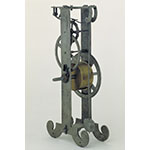This model, showing the application of the pendulum to the clock, revives the concept developed by Galileo as early as 1637. The iron frame holds brass gears. The train comprises two wheels and two pinions. The escapement is composed of: a wheel with 12 teeth along the rim and 12 pegs placed crosswise along the rim as well; a retaining lever powered by a thin spring; and two long upward-curved pallets, integral with the pendulum at its hinge point (the upper pallet is for release, the lower one receives the impulse). At the end of each oscillation the upper pallet meets the retaining lever and lifts it, freeing the escapement wheel. As the latter rotates, it meets the lower pallet and pushes it down, imparting the impulse needed to keep the pendulum moving. As the impulse pallet is pushed downward, it lowers the upper pallet as well, which consequently drops the retaining lever blocking the wheel. The pendulum is free to travel the remainder of its arc path, returning to the opposite end. There, it lifts the retaining lever, releasing the wheel and so starting a new cycle. Release and impulse occur in rapid succession at the end of every complete oscillation. One of the drawings (inv. 2433) by Vincenzo Viviani and Galileo's son Vincenzo Galilei was rediscovered in 1855: it illustrated the first application to the clock of the pendulum concept invented by Galileo. The discovery fostered the construction of countless models. This one, built in 1879 by Eustachio Porcellotti, was one of the first (the Museum has another copy by the same maker, dating from two years earlier).










